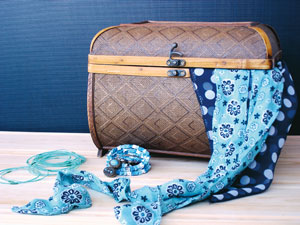By Stephanie Finnegan
Who doesn’t love “love”? Well, surveys say that even though a person might be romantic 364 days a year, the big, bold, red-letter day of February 14 raises the hackles on many men (and some women, too). The grumbling that it is nothing more than a “Hallmark holiday” has found a home base with many gents, and a few cynical gals as well. These consumers don’t want to part with their hard-earned cash on a day that they feel is trumped up and over-trumpeted.
Luckily, though, for retailers, there still remain a healthy number of American shoppers who want to bestow their loved one with a token of their affection on the appropriate, calendar-based Valentine’s Day. What’s most interesting, in fact, is that the classification of “loved one” is growing yearly to “loved ones.” What used to be just a rite of passage for people who were married or courting has now become an excuse to buy cards and gifts for anyone who is in a social circle. That’s good news for you, the smart retailer. For every guy who has decided to sit this Valentine’s Day out as a social protest, you have the chance to pick up extra sales for kids, grandparents, teachers, coaches, and even pets! (Rakuten e-commerce sites estimated that in 2013 U.S. consumers spent $375 million on their pets for the holiday. Talk about puppy love!)
Timing Is Everything
Just like with a great romance, the “where” and the “when” really matter. When should you start promoting the holiday? It’s the same date every year—February 14—so should you begin the sales pitches a month early?
According to an in-depth study funded by the University of Georgia, this is a late-buying—an almost guaranteed last-minute—holiday event. Christmas shopping has ended on December 24, and the big influx of Noel returns and cashing in of gift cards for purchases, extends the Christmas season into early to mid-January. People are still wrapped up in the aftermath of having done all their Christmas wrapping; they are not mentally geared up for another holiday buying spree. Said one retail executive interviewed for the Georgian study: “People are tired, broke, and are saddled six weeks later with having to give another gift to their spouse. It’s exhausting.”
Additionally, Christmas has become positioned more and more as a festive, romantic holiday. With people getting married later and later—and sizes of families diminishing nationally—advertising campaigns online casino that use bitcoin have painted Christmas as a way to show off one’s seasonal and sensual love. (Think about all the commercials that accentuate husbands and wives, boyfriends and girlfriends, surprising one another with diamond rings and luxury cars!)
So, with the Thanksgiving break to mid January tied up with Christmas, when should you raise the specter of Valentine’s Day? A good rule of thumb is to have the Valentine’s signage and decorations up in mid January (catching the attention of those Christmas exchangers and gift-card shoppers) but don’t expect them to start purchasing products in earnest until the end of January or first week of February if they’re female (three days before Valentine’s Day right up until Valentine’s Day night if they are male).
How to Catch the Female Eye?
If you are courting these holiday-fatigued shoppers, how do you capture their attention and their dollars? For women, the answer is greeting cards. Women are the largest buyers of sentimental notecards and other paper-based, heartfelt expressions. Almost 80 to 85 percent of all Valentine’s Day cards are purchased by women. This is because the outpouring of affection has gone from just their significant other to their kids, parents, in-laws, friends, coworkers, and anyone else who has made them feel happy or given them a laugh over the past year. Valentine’s Day—for women—has become more of a “feel good” celebration rather than a “make love” occasion. Greeting cards are a way for women to send good thoughts and good vibrations to the folks in their social circles.
If the woman is involved in a romantic relationship, she will buy her partner a gift, but the gifts are not the traditional bestsellers of candy, flowers, or jewelry. (Those are still the big three for men to purchase.)
Women will buy clothing for their men (ties, shirts, novelty boxers) are popular in this category. They will also buy tickets for shows and concerts, or make reservations for a night out with their special someone. From the female perspective, this is a night to go out and be entertained.
To attract a female customer, if you carry ties, shirts, and boxers—by all means, put them out to be examined and handled and purchased for their man. If that’s not your purview, still utilize these “magnets” to draw in the customer.
Drape some ties enticingly around the tables that hold what you do sell. If you’re showcasing colognes or aftershave lotion for men, why not have them draped with ties or set up a sign that details the “Must Buys” for a romantic night out on the town? Incorporate how your items are the perfect added-on touches for a night out: Don’t you want your guy to smell nice? Look good? Be extra handsome?
Or snake the ties around whatever you sell: a silk tie wending around a picture frame or serving as a backdrop for your inventory will get women to come over, pick up, and (hopefully) buy. (If you have picture frames, why not put copies of your wedding day photos or your staff’s photos to create a conversation starter? Share Xeroxes of your best-loved days with your customers.)
Do It Yourself Valentine’s Day: Female Edition
If divorce has left a woman without a spouse, and she’s not currently dating anew, she still will take part in the Valentine’s merriment. Teleflora says that 15% of women will send themselves flowers on February 14. They send the arrangements to either their home or office, or to both.
They’ll also buy scented candles, lotions, cosmetics, and fragrances for themselves for the holiday. Whether it’s because they’re celebrating solo or they want to set the mood for their partner, these aromatic items spike among female consumers at this time of year.
Also keep in mind, women will buy scented candles for their female friends as a housewarming gift or a thank-you present. With Valentine’s Day becoming more of a day of affection for many customers—not sexual love—these friendship gifts hold wide appeal for the female client.
Bring your candles, potpourri, and fragrances to the forefront of your shop. As they are bought, make sure to replenish them. Nothing looks less appetizing than a picked-over selection of goodies. If you have additional stock in your back room, make sure to move it out and add it to the display. You can’t sell it if it is lingering in the storage closet.
Women also buy Valentine’s gifts for their children. The Frozen juggernaut is certain to remain a hot seller for the young girls in your customers’ lives. Likewise, anything Lego or building block associated is a great Valentine’s treat for little boys. (Teenage Mutant Ninja Turtles are enjoying a huge resurgence.) Set up a shopping space for the kids in your customers’ families. Post it as “Big Love for the Little Ones” or “Lots of Love for Tots.” Moms, grandmothers, aunts, and other female shoppers will definitely take time out to explore and consider.
What Men Think Women Want . . . Want Them to Want
Left to their own devices, many men would head to the lingerie boutique and the liquor store and then arrive home with a very specific Valentine’s Day activity in mind. However, that initial impulse gets put on “hold” and the men go for the tried-and-true customary gifts. As stated above, it’s the men who keep the purchasing of boxes of candy, flowers, and jewelry alive.
Knowing this, a smart retailer can create stations—placed up front where they can’t be missed—that show off these staples as both individual purchases or as ready-made sets.
Since so many men shop for Valentine’s Day from February 11 through February 14, they are short on time but still long on desire. Create matching pairs of items that will snag their attention: necklaces and earrings that complement one another and can be bought as a pair; candy and jewelry that both catch the light and look high-end and luxurious, like Godiva and gemstones, Dove and diamonds. Just because a male shopper has waited until the last minute to buy his present, that doesn’t mean he wants it to come across as rushed and a flop.
If you sell plush animals—cute teddy bears, cats, dogs, penguins, etc.—offer them with jewelry smartly wrapped around their necks as chokers or leashes. Use your creativity to construct a multi-leveled gift. It will look fantastic; it will attract the man’s interest; it will increase your sales.
If you have the manpower (or, more likely, womanpower), offer wrapping services for the Valentine’s Day gifts. Professional wrapping—with neatly cut paper and bows—might be the extra touch to guarantee sales from men.
Social Networks Mean Socializing, Spending, and Swooning
Even with the anti-love brigade out there, Forbes magazine calculated that consumers spent $19 billion on Valentine’s Day in 2014. That’s a heck of a lot of currency, and your shop can be a part of that.
Online viewing and buying have grown in popularity, and it’s especially true for Valentine’s Day. Respondents in a Fairleigh Dickinson University poll admit that they do their online shopping at work, during business hours, so as to avoid their partner stumbling across their selected purchases.
The Fairleigh Dickinson investigation tracked when retailers began to send out their e-mails, known as V-mails for the social scientists’ polling purposes. The first V-mail came to consumers on January 8, and it didn’t net large sales. The bulk of the mailing—and the bulk of the results—happened in February. For the year that they chronicled, the heaviest volume of V-mailing by retailers to receptive shoppers happened on February 8, February 6, and February 12. The February 8 mailing got the most hits and buys.
One of the advantages of the online sales pitch is that no physical space needs to be decorated or assigned for merchandise to be promoted and pushed. You can create the Valentine’s connection via your headings and blogging. If you have a lot of kitchen items, promote it as “A Way to a Man’s Heart.” Push the culinary items; promote how a good meal is a way to make him happy.
If you have funny, comical items—gag gifts, cute impulse buys—slug them as “Love to Laugh? Laugh and Love!”
Remember, these tips that you can use in your e-mail outreach can also be used in your brick-and-mortar shop. You can buck the trend of candles, candy, and cuff links, and add love-centric signs to your everyday merchandise.
With some gumption and ingenuity, you can make your shop a must-see spot for love and lots of commerce.
Strategies You’ll Love . . . So Will Your Customers
It’s a startling figure, but it puts it all into perspective. According to the Statistic Brain website, 53 percent of women said that they would end a relationship if they didn’t get a gift on Valentine’s Day. With such a heavy onus on the shopper and the seller, what can you do to make sure these women don’t have to break up on February 15?
Sponsor a Contest: Invite your customers—new and old—to share happy memories or photographs from past Valentine’s Days or romantic getaways. The winning entries—you choose the victor—can get a gift card to your store. Make the winning gift card $20 or $25. Hopefully, that will get them into your shop, and entice them to spend more. (It’s a great, inexpensive way to capture names, e-mail addresses, Facebook pages, or whatever means you use to run the giveaway/contest.)
A Bud for Your Buddies: Buy bouquets of flowers from your local florist, grocer, bodega, or other floral outlet. On February 12 to February 14, offer a free flower for every $5 spent (make sure the dollar amount is more than what you’ve spent for the flowers). So, a person buying $50 worth of goods could qualify for 10 lovely flowers to accompany his or her gifts. A person spending $25 would get 5 flowers, and so on. It’s a fun way to perk up the interest of last-minute shoppers and a way to add to your shop’s allure as a quirky, romantic hot spot.
In the Pink: Even if you don’t sell traditional Valentine’s gifts, you can still put shoppers in the mood to buy, if you drape and decorate with lots of reds, pinks, silvers, and gold. Don’t be afraid to lay it on thick. The colors will trigger the association. Use pink and red tablecloths. If you have doilies or velvet cloths to drape over stands, add those hints of elegance and romance. Colors make a statement: they can transform vases or water bottles, jewelry boxes or humidors, into a gift to consider for the holiday.
Partner with Your Neighbors. Let Valentine’s Day be the start of a beautiful relationship between you and your local businesses. Cozy up with a restaurant and share a night out with them. If a person dines at the restaurant, they get a 10% coupon for your shop or a $10 discount for your shop. Likewise, if they shop at your store, they’ll get a coupon for discounts or certain dollars off a meal at the partnering restaurant. Same with movie theaters, concert venues, and other businesses in your neck of the woods—now is the time to forge a lasting, loving relationship that can help all of you in this risky economic clime.
Stephanie Finnegan is a senior contributor at JP Media LLC. A former editor of THE CRAFTS REPORT and SMART RETAILER, she is well versed in how commerce and creativity intersect. A contributor to HANDMADE BUSINESS and SUNSHINE ARTIST, Stephanie loves to showcase how artists rise to the challenge of being enterprising and entrepreneurial in today’s competitive climate. An author of several books on collectibles and American artists, she has also written a time-travel book and a series of short stories. Stephanie can be reached at www.stephaniefinnegan.com












